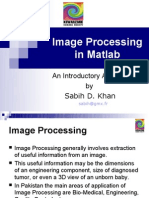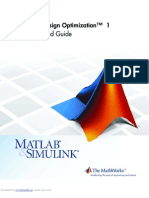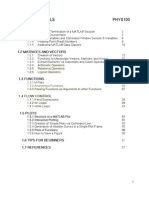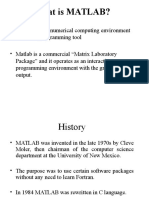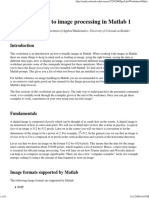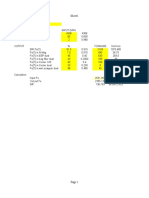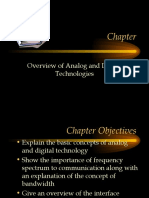Image Processing Using MATLAB
Uploaded by
amadeus99Image Processing Using MATLAB
Uploaded by
amadeus99Image Processing Using MATLAB
www.techsource.com.my
Image Processing Using MATLAB®
TechSource Systems Sdn. Bhd.
©2005 Systems Sdn. Bhd.
www.techsource.com.my
Course Outline:
1. Working with Images in MATLAB
a) Image types and classes
b) Read/write images
c) Display images
2. Basic Image Processing
a) Image contrast and brightness enhancement
b) Image arithmetic
3. Block Processing of Images
4. Image Restoration
a) Noise reduction (filtering)
b) Image alignment
5. Image Segmentation & Edge Detection
6. Case Studies
©2005 Systems Sdn. Bhd.
Copyrighted 2005 TechSource Systems
Sdn Bhd 1
Image Processing Using MATLAB
Working with Images in MATLAB www.techsource.com.my
Section Outline:
1. Image types
• Index images
• Intensity images
• Binary images
• RGB images
2. Importing and exporting images in MATLAB
• imfinfo
• imread and imwrite
• imshow
3. Converting between image formats
©2005 Systems Sdn. Bhd.
Working with Images in MATLAB www.techsource.com.my
Image Types
• Four basic types of images are supported in
MATLAB
• Index images: m-by-3 colormap matrix
• Intensity images: [0 1] or uint8
• Binary images: {0, 1}
• RGB images: m-by-n-by-3 matrix
>> load sampleImages
©2005 Systems Sdn. Bhd.
Copyrighted 2005 TechSource Systems
Sdn Bhd 2
Image Processing Using MATLAB
Working with Images in MATLAB www.techsource.com.my
Image Types: MATLAB Data Types Used
• A wide array of different data types exist in
MATLAB, but only a subset of the data types are
used to represent images in MATLAB.
Image data types
©2005 Systems Sdn. Bhd.
Working with Images in MATLAB www.techsource.com.my
Image Types: Index Images
• An indexed image consists of a data matrix, X, and a
colormap matrix, map.
>> imshow(indexImg, map)
©2005 Systems Sdn. Bhd.
Copyrighted 2005 TechSource Systems
Sdn Bhd 3
Image Processing Using MATLAB
Working with Images in MATLAB www.techsource.com.my
Image Types: Intensity Images
• An intensity image only consists of one matrix, I,
whose values represent intensities within some
range, for example [0 1] or uint8.
>> imshow(intenImg)
©2005 Systems Sdn. Bhd.
Working with Images in MATLAB www.techsource.com.my
Image Types: Binary Images
• In a binary image, each pixel assumes one of only
two discrete values: 0 (off) and 1 (on).
>> imshow(bwImg)
©2005 Systems Sdn. Bhd.
Copyrighted 2005 TechSource Systems
Sdn Bhd 4
Image Processing Using MATLAB
Working with Images in MATLAB www.techsource.com.my
Image Types: RGB Images
• RGB image is stored in MATLAB as an m-by-n-by-3
data where each m-by-n page defines red (R), green
(G) and blue (B) color components for each pixel.
>> imshow(rgbImg)
©2005 Systems Sdn. Bhd.
Working with Images in MATLAB www.techsource.com.my
Overview: How Images are Represented?
Image Type Indexed Intensity Binary RGB
Image is an M-by-N Image is an M-by-N Image is an M-by- Image is an
array of integers in the array of floating- N logical array M-by-N-by-3
range [1,P]. point values. The containing only 0's array of
conventional and 1's. floating-point
Double Colormap is a P-by-3 dynamic range is values in the
Data array of floating-point [0,1]. range [0,1].
values in the range [0,1].
Image is an M-by-N Image is an M-by-N Image is an M-by- Image is an
array of integers in the array of unsigned 8- N logical array M-by-N-by-3
range [0,P-1]. bit integers. The containing only 0's array of
conventional and 1's. Unlike floating-point
Uint8 Colormap is a P-by-3 dynamic range is uint8 intensity values in the
Data array of floating-point [0,255]. images, 1 range
values in the range [0,1]. represents white [0,255].
©2005 Systems Sdn. Bhd.
Copyrighted 2005 TechSource Systems
Sdn Bhd 5
Image Processing Using MATLAB
Working with Images in MATLAB www.techsource.com.my
Color Space of RGB and HSV
• There are two main types of color spaces that are
used with images: RGB and Hue-Saturation- Value
(HSV).
©2005 Systems Sdn. Bhd.
Working with Images in MATLAB www.techsource.com.my
Importing and Exporting Images in MATLAB
• Image Processing Toolbox
• imfinfo- Returns info about graphics file.
• imread - Read image from graphics file.
• imwrite- Write image to graphics file.
• MATLAB
• uiimport - Starts the Import Wizard.
>> imfinfo(‘canoe.tif’)
>> [X, map] = imread(‘canoe.tif’);
>> imshow(X, map);
>> imwrite(X, map, ‘canoe2.bmp’);
©2005 Systems Sdn. Bhd.
Copyrighted 2005 TechSource Systems
Sdn Bhd 6
Image Processing Using MATLAB
Working with Images in MATLAB www.techsource.com.my
Graphical Representation of Importing an Image
Colormap?
imfinfo('file.fmt')
file.fmt x=imread('file.fmt');
[x,map]=imread('file.fmt');
Im age Intensity Binary RGB
Image Indexed Type
Type Double
1 0 1 0.9 0.4
1 0.5 0.2
Double Data 0 0.1 0.9 0 1 0
0.1 0.7
0.5 0.3
0.2
1 0.5 0.3
Data [MXN] + 0 0.7 0.8 0 1 1
0.9 0.2
Uint8 90 140
Uint8 Data 1 45 220
100 78 110
1 0 1 225 30
100 70
0 1 0
Data [MXN] + 200 7 98 0 1 1
22 230
10 50
109 220
©2005 Systems Sdn. Bhd.
Working with Images in MATLAB www.techsource.com.my
Displaying Images
• imshow - Display image.
• image - Create and display image object (MATLAB).
• imagesc - Scale data and display as image (MATLAB).
• colorbar - Display colorbar (MATLAB).
• colormap - Sets the color map of the image (MATLAB).
• montage - Display multiple image frames.
• truesize - Adjust display size of image.
• warp - Display image as texture-mapped surface.
©2005 Systems Sdn. Bhd.
Copyrighted 2005 TechSource Systems
Sdn Bhd 7
Image Processing Using MATLAB
Working with Images in MATLAB www.techsource.com.my
Montage
• An example of displaying multiple image frames as a
rectangular montage.
>> load mri
>> montage(D, map)
©2005 Systems Sdn. Bhd.
Working with Images in MATLAB www.techsource.com.my
Warping
• The warp function allows you to display an image as
a texture-mapped surface.
>> [x, y, z] = sphere;
>> load earth
>> warp(x, y, z, X, map)
©2005 Systems Sdn. Bhd.
Copyrighted 2005 TechSource Systems
Sdn Bhd 8
Image Processing Using MATLAB
Working with Images in MATLAB www.techsource.com.my
Converting Image Formats
• ind2gray – indexed image to intensity image.
• ind2rgb – indexed image to RGB image (MATLAB).
• gray2ind – intensity image to indexed image.
• rgb2gray – RGB image or colormap to grayscale.
• rgb2ind – RGB image to indexed image.
• mat2gray – matrix to intensity image.
• im2bw – image to binary image by thresholding.
• im2double – image array to double precision.
• im2uint8 – image array to 8-bit unsigned integers.
• im2uint16 – image array to 16-bit unsigned integers.
©2005 Systems Sdn. Bhd.
Working with Images in MATLAB www.techsource.com.my
Exercise 1: Loading and Viewing an Image
1. Load in the trees.tif file into MATLAB.
– What type of image is it? Can you tell before
loading in the file?
2. Display the loaded image.
3. Convert the image to an intensity image (grayscale).
4. Now convert it to a binary (black and white) image.
Extra credit:
1. Use subplots to display all three images.
2. Did you find the "Easter egg" in the "trees"?
©2005 Systems Sdn. Bhd.
Copyrighted 2005 TechSource Systems
Sdn Bhd 9
Image Processing Using MATLAB
Working with Images in MATLAB www.techsource.com.my
Solution: Loading and Viewing an Image
>> im_info = imfinfo('trees.tif');
>> im_info(1).ColorType Why use subimage?
>> [I,map] = imread('trees.tif');
>> subplot(2,2,1), subimage(I,map)
>> I_gray = ind2gray(I,map);
>> subplot(2,2,2), subimage(I_gray) Threshold
>> I_bw = im2bw(I,map,0.4);
>> subplot(2,2,3), subimage(I_bw)
% Easter egg
>> figure
>> [I2,map] = imread('trees.tif',2);
>> imshow(I2,map)
©2005 Systems Sdn. Bhd.
Working with Images in MATLAB www.techsource.com.my
Section Summary:
1. Image types
• Index images
• Intensity images
• Binary images
• RGB images
2. Importing and exporting images in MATLAB
• imfinfo
• imread and imwrite
• imshow
3. Converting between image formats
©2005 Systems Sdn. Bhd.
Copyrighted 2005 TechSource Systems
Sdn Bhd 10
Image Processing Using MATLAB
Basic Image Processing www.techsource.com.my
Section Outline:
1. Image enhancement
• Image histogram
• Image contrast adjustment
• Image brightness adjustment
2. Image thresholding
3. Image arithmetic
©2005 Systems Sdn. Bhd.
Basic Image Processing www.techsource.com.my
Image Enhancement
• One of the most basic ways to enhance an image is
to change its brightness and its contrast, and this
can be done is by working with the image's
histogram.
– By stretching the color distribution
– By equalizing the distribution of colors to use the
full range
– By adjusting the scaling of the colors
• If you are separating an object from its background,
thresholding is a technique that could be used as
well.
©2005 Systems Sdn. Bhd.
Copyrighted 2005 TechSource Systems
Sdn Bhd 11
Image Processing Using MATLAB
Basic Image Processing www.techsource.com.my
Histogram
• A histogram of an image shows the current level of
contrast (the distribution of gray levels).
>> I = imread('pout.tif');
>> imshow(I)
>> figure, imhist(I)
©2005 Systems Sdn. Bhd.
Basic Image Processing www.techsource.com.my
Histogram Stretching
• One way to increase the contrast of an image is to
stretch the pixel values (min == 0 and max == 255).
I − I min
J = 255 ⋅
I max − I min
©2005 Systems Sdn. Bhd.
Copyrighted 2005 TechSource Systems
Sdn Bhd 12
Image Processing Using MATLAB
Basic Image Processing www.techsource.com.my
Histogram Equalization
• The histeq function can be used to equally
distribute the histogram and enhance the contrast.
>> J = histeq(I);
©2005 Systems Sdn. Bhd.
Basic Image Processing www.techsource.com.my
Histogram Adjustment
• Intensity adjustment is a technique for mapping an
image's intensity values to a new range (imadjust).
>> I = imread('cameraman.tif');
>> J = imadjust(I,[0 0.2],[0.5 1]);
>> imshow(I)
>> figure, imshow(J)
©2005 Systems Sdn. Bhd.
Copyrighted 2005 TechSource Systems
Sdn Bhd 13
Image Processing Using MATLAB
Basic Image Processing www.techsource.com.my
Understanding Intensity Adjustment
• The following example demonstrates how an image's
intensity can be changed to enhance different characteristics
of an image.
>> imadjdemo
©2005 Systems Sdn. Bhd.
Basic Image Processing www.techsource.com.my
Image Thresholding
• The adjusted cameraman image can be thresholded to
create a black and white image of the cameraman and
the camera.
©2005 Systems Sdn. Bhd.
Copyrighted 2005 TechSource Systems
Sdn Bhd 14
Image Processing Using MATLAB
Basic Image Processing www.techsource.com.my
Using imtool GUI for Image Analysis
• The imtool is an image display GUI that provides access to
Pixel Region tool, the Image Information tool, and the Adjust
Contrast tool.
©2005 Systems Sdn. Bhd.
>> imtool(‘moon.tif’)
Basic Image Processing www.techsource.com.my
Image Arithmetic
• With just simple addition, subtraction, multiplication and
division a number of different image processing techniques can
be implemented.
– With addition and multiplication an image contrast can be
increased that facilitates edge detection process.
– With subtraction and division changes can be detected from one
image to another.
imabsdiff - Compute absolute difference of two images
imadd - Add two images or add constant to image
imcomplement - Complement image
imdivide - Divide two images or divide image by a constant
imlincomb - Compute linear combination of images
immultiply - Multiply two images or multiply image by constant
imsubtract - Subtract two images or subtract constant from image
©2005 Systems Sdn. Bhd.
Copyrighted 2005 TechSource Systems
Sdn Bhd 15
Image Processing Using MATLAB
Basic Image Processing www.techsource.com.my
Image Addition
• Image addition makes it possible to superimpose an
image on top of another or control the brightness of an
image.
• Each resulting pixel is the sum of the respective pixels
of the two images, of the same size and of the same
class.
>> I1 = imread(‘peppers.png’);
>> I2 = imadd(I1, 50);
>> subplot(2,1,1), imshow(I1)
>> subplot(2,1,2), imshow(I2)
>> % MATLAB 7 New Features
>> I1 = imread(‘peppers.png’);
>> I2 = I1 + 50 % direct addition
>> subplot(2,1,1), imshow(I1)
>> subplot(2,1,2), imshow(I2)
©2005 Systems Sdn. Bhd.
Basic Image Processing www.techsource.com.my
Image Addition (Continued)
>> I = imread(‘rice.png’);
>> J = imread(‘cameraman.tif’);
>> K = imadd(I, J);
>> imshow(K)
>> % MATLAB 7 New Features
>> I = imread(‘rice.png’);
>> J = imread(‘cameraman.tif’);
>> K = I + J; % direct addition
>> imshow(K);
©2005 Systems Sdn. Bhd.
Copyrighted 2005 TechSource Systems
Sdn Bhd 16
Image Processing Using MATLAB
Basic Image Processing www.techsource.com.my
Image Multiplication
>> I = imread(‘moon.tif’);
>> J = immultiply(I, 1.2);
>> subplot(1,2,1),imshow(I)
>> subplot(1,2,2),imshow(J)
>> % MATLAB 7 New Features
>> I = imread(‘moon.tif’);
>> J = 1.2 * I; % direct multiply
>> subplot(1,2,1),imshow(I)
>> subplot(1,2,2),imshow(J)
©2005 Systems Sdn. Bhd.
Basic Image Processing www.techsource.com.my
Image Subtraction
• Can you see anything different about the two images?
©2005 Systems Sdn. Bhd.
Copyrighted 2005 TechSource Systems
Sdn Bhd 17
Image Processing Using MATLAB
Basic Image Processing www.techsource.com.my
• Using subtraction, you can identify the following
differences.
Did the image match
up with what you were
expecting?
>> [im1, map1] = imread(‘change1.gif’);
>> [im2, map2] = imread(‘change2.gif’);
>> im_diff = imsubtract(im1, im2);
>> % im_diff = im1 – im2; % direct subtraction
>> imshow(im_diff)
>> colormap(jet)
>> set(gca, ‘clim’, [0 60]); % adjust colorbar
©2005 Systems Sdn. Bhd.
Basic Image Processing www.techsource.com.my
Exercise 2: Image Division
• Repeat what you just did with image subtraction,
except, this time, use division instead.
©2005 Systems Sdn. Bhd.
Copyrighted 2005 TechSource Systems
Sdn Bhd 18
Image Processing Using MATLAB
Basic Image Processing www.techsource.com.my
Solution: Loading and Viewing an Image
>> [im1, map1] = imread(‘change1.gif’);
>> [im2, map2] = imread(‘change2.gif’);
>> im_diff = imdivide(im1, im2);
>> % im_diff = im1./im2; % direct element-wise division
>> imshow(im_diff)
>> colormap(map1)
>> min(im_diff(:)); % ans = 0
>> max(im_diff(:)); % ans = 5
>> set(gca, ‘clim’, [0 5])
©2005 Systems Sdn. Bhd.
Basic Image Processing www.techsource.com.my
Section Summary:
1. Image enhancement
• Image histogram
• Image contrast adjustment
• Image brightness adjustment
2. Image thresholding
3. Image arithmetic
©2005 Systems Sdn. Bhd.
Copyrighted 2005 TechSource Systems
Sdn Bhd 19
Image Processing Using MATLAB
Block Processing of Images www.techsource.com.my
Section Outline:
1. What is block processing?
2. Distinct block operations
3. Sliding neighbourhood operations
4. Example of block processing
• Convolution
• Correlation
5. Column processing
©2005 Systems Sdn. Bhd.
Block Processing of Images www.techsource.com.my
What is block processing?
An operation in which an image is processed in blocks
rather than all at once.
• The blocks have the same size across the image.
• An operation is applied to one block at a time.
• Once processed, the blocks are re-assembled to
form an output image.
©2005 Systems Sdn. Bhd.
Copyrighted 2005 TechSource Systems
Sdn Bhd 20
Image Processing Using MATLAB
Block Processing of Images www.techsource.com.my
Distinct Block Operations
Distinct blocks are rectangular partitions that divide an
image matrix into m-by-n sections.
• Blocks are overlaid by starting at the upper-left corner.
• Zeros are padded onto blocks that exceed the size of
the image.
Single
block n Zero-padding
B = blkproc(A,[m n],fun)
©2005 Systems Sdn. Bhd.
Block Processing of Images www.techsource.com.my
Block Processing – Averaging Filter
Find the average value of each 8-by-8 block and replace all
the pixels in the block with the average value.
>> I1 = imread('tire.tif');
>> f = @(x) uint8(round(mean2(x)*ones(size(x))))
>> I2 = blkproc(I1,[8 8], f);
>> subplot(1,2,1), imshow(I1)
>> subplot(1,2,2), imshow(I2) Function handle
©2005 Systems Sdn. Bhd.
Copyrighted 2005 TechSource Systems
Sdn Bhd 21
Image Processing Using MATLAB
Block Processing of Images www.techsource.com.my
Sliding Neighborhood Operations
Each center pixel value is determined by applying some
algorithm to its neighboring pixels of a defined size –
neighborhood
Center pixel
n
Neighborhood
m
B = nlfilter(A,[m n],fun) Note:
For an m-by-n neighborhood, the center
©2005 Systems Sdn. Bhd.
pixel is floor(([m n]+1)/2)
Block Processing of Images www.techsource.com.my
Sliding Neighborhood Operations –
Nonlinear Filter
Replace each pixel with the standard deviation of the
values of the input pixel's 3-by-3 neighborhood.
>> I1 = imread('tire.tif');
>> f = @(x) uint8(round(std2(x))); % function handle
>> I2 = nlfilter(I1,[3 3], f);
>> subplot(1,2,1), imshow(I1)
>> subplot(1,2,2), imshow(I2)
©2005 Systems Sdn. Bhd.
Copyrighted 2005 TechSource Systems
Sdn Bhd 22
Image Processing Using MATLAB
Block Processing of Images www.techsource.com.my
Example of Block Processing - Convolution
In convolution, the value of an output pixel is computed as
a weighted sum of neighboring pixels. The matrix of
weights is called the convolution kernel (or filter).
Steps for convolving an image
• Rotate the convolution kernel 180 degrees about the
center.
• Slide the rotated convolution kernel over the image.
• Multiply each weight in the rotated convolution kernel
by the pixel of the image
• Sum up all individual products.
©2005 Systems Sdn. Bhd.
Block Processing of Images www.techsource.com.my
Given an image, A, and the convolution kernel, h, the
procedure for calculating the convolution for the value of
14 would be as follows.
• Notice that in the calculation the convolution kernel,
h, is rotated a 180 degrees.
>> A = [17 24 1 8 15
23 5 7 14 16
4 6 13 20 22
10 12 19 21 3
11 18 25 2 9]
>> h = [8 1 6
3 5 7
4 9 2]
>> conv2(A,h, ‘same’)
©2005 Systems Sdn. Bhd.
Copyrighted 2005 TechSource Systems
Sdn Bhd 23
Image Processing Using MATLAB
Block Processing of Images www.techsource.com.my
Example of Block Processing - Correlation
In correlation, the value of an output pixel is also
computed as a weighted sum of neighboring pixels. The
difference is that the matrix of weights (correlation kernel)
is not rotated.
>> A = [17 24 1 8 15
23 5 7 14 16
4 6 13 20 22
10 12 19 21 3
11 18 25 2 9]
>> h = [8 1 6
3 5 7
4 9 2]
>> filter2(h,A)
©2005 Systems Sdn. Bhd.
Block Processing of Images www.techsource.com.my
Column Processing
Arranging each sliding neighborhood or distinct block as
separate columns, and process each column as a block.
• Faster, since most of MATLAB is column-based.
• But uses more memory.
Syntax
B = colfilt(A,[m n],block_type,fun)
A – image matrix
[m n] – size of block
block_type – Either 'distinct' or 'sliding'
fun – function to apply
©2005 Systems Sdn. Bhd.
Copyrighted 2005 TechSource Systems
Sdn Bhd 24
Image Processing Using MATLAB
Block Processing of Images www.techsource.com.my
>> I1 = imread('tire.tif');
>> f = @(x) uint8(round(std(double(x))));
>> I2 = colfilt(I1,[3 3],'sliding',f);
>> subplot(1,2,1), imshow(I1)
>> subplot(1,2,2), imshow(I2)
©2005 Systems Sdn. Bhd.
Block Processing of Images www.techsource.com.my
Section Summary:
1. What is block processing?
2. Distinct block operations
3. Sliding neighbourhood operations
4. Example of block processing
• Convolution
• Correlation
5. Column processing
©2005 Systems Sdn. Bhd.
Copyrighted 2005 TechSource Systems
Sdn Bhd 25
Image Processing Using MATLAB
Image Restoration www.techsource.com.my
Section Outline:
1. Reducing noise
• Filters
• Region-based processing
2. Image alignment
• Rotation
• Cropping
• Resizing
©2005 Systems Sdn. Bhd.
Image Restoration www.techsource.com.my
Reducing Noise
Where does noise come from?
• Scanner resolution
• Film grain (granularity)
• Hardware (interference patterns)
• Other
Common types of noise
• Whitenoise (Gaussian)
• Local variance (Gaussian with intensity-dependent
variance)
• Salt and pepper
• Speckle
©2005 Systems Sdn. Bhd.
Copyrighted 2005 TechSource Systems
Sdn Bhd 26
Image Processing Using MATLAB
Image Restoration www.techsource.com.my
A filter can be used to reduce the effect of noise in an
image. The Image Processing Toolbox provides three
main methods of filtering:
• Linear filtering
• Median filtering
• Adaptive filtering
Different methods are better for different kinds of noise.
In the following section we will investigate the types of
methods, and what type of noise they are most effective
in reducing.
©2005 Systems Sdn. Bhd.
Image Restoration www.techsource.com.my
How Do I Model Noise?
The function imnoise allows different types of
noise to be modeled.
Syntax:
J = imnoise(I,type,parameters)
I – Image
type – gaussian, localvar, poisson,
salt & pepper, speckle
parameters – additional parameters needed
given the type of noise
©2005 Systems Sdn. Bhd.
Copyrighted 2005 TechSource Systems
Sdn Bhd 27
Image Processing Using MATLAB
Image Restoration www.techsource.com.my
Linear Filtering
A linear filter computes each output pixel value according
to a linear combination of the input pixel's neighborhood.
• The basics of linear filtering are done through
correlation and convolution.
• In the Image Processing Toolbox both these
operations are performed using the imfilter
command.
©2005 Systems Sdn. Bhd.
Image Restoration www.techsource.com.my
Filtering using imfilter
Syntax
B = imfilter(A,H)
B = imfilter(A,H,option1,option2,...)
A – Input image
H – The filter, also known as the
correlation/convolution kernel
options – Boundary options, output size option,
correlation and convolution option
Note: By default imfilter performs correlation.
©2005 Systems Sdn. Bhd.
Copyrighted 2005 TechSource Systems
Sdn Bhd 28
Image Processing Using MATLAB
Image Restoration www.techsource.com.my
Averaging Filter
A very basic example of a linear filter is an averaging filter.
>> I = imread('cameraman.tif');
>> % addition of graininess (i.e. noise)
>> I_noise = imnoise(I, 'speckle', 0.01);
>> % the average of 3^2, or 9 values
>> h = ones(3,3) / 3^2;
>> I2 = imfilter(I_noise,h);
>> subplot(1,2,1), imshow(I_noise), title('Original image')
>> subplot(1,2,2), imshow(I2), title('Filtered image')
©2005 Systems Sdn. Bhd.
Image Restoration www.techsource.com.my
Special Linear Filters
The function fspecial creates a variety of two-
dimensional filters.
Syntax
h = fspecial(type, parameter)
h – two-dimensional correlation kernel
type – one of the specified special filter types:
gaussian, sobel, prewitt, laplacian, log,
motion, averaging (average), circular averaging
(disk), and a contrast sharpening (unsharp) filter
parameters – particular to the type of filter chosen
©2005 Systems Sdn. Bhd.
Copyrighted 2005 TechSource Systems
Sdn Bhd 29
Image Processing Using MATLAB
Image Restoration www.techsource.com.my
Exercise 3: Investigating Linear Filters
• Create a checkerboard image using the
checkerboard function.
• Filter the checkerboard image with each fspecial
filter type and display the image. For each filter type
you can just use its default parameter(s).
• Extra credit: Display all nine images in one figure.
©2005 Systems Sdn. Bhd.
Image Restoration www.techsource.com.my
Solution: Investigating Linear Filters
>> I = checkerboard;
>> type = {'gaussian','sobel','prewitt',...
'laplacian','log','motion',...
'average','disk','unsharp'}; % cell arrays
>> for index = 1:length(type)
h = fspecial(type{index});
I2 = imfilter(I,h);
subplot(3,3,index)
imshow(I2)
title(type{index})
end
©2005 Systems Sdn. Bhd.
Copyrighted 2005 TechSource Systems
Sdn Bhd 30
Image Processing Using MATLAB
Image Restoration www.techsource.com.my
Median Filtering
When noise causes the pixels to vary greatly from
the original value (salt and pepper), a median filter
is more effective in reducing the noise.
Syntax
B = medfilt2(A,[m n])
A – Input image
B – Output image
[m n] – Neighborhood block size to be used to
calculate the median.
©2005 Systems Sdn. Bhd.
Image Restoration www.techsource.com.my
Example: Median Filter
>> I = imread('eight.tif');
>> I_noise = imnoise(I,'salt & pepper');
>> h = fspecial('average',[3 3]);
>> I_avg = imfilter(I_noise,h);
>> I_med = medfilt2(I_noise, [3 3]);
>> subplot(2,2,1.5)
>> imshow(I_noise), title('Quarters w/ Salt & Pepper')
>> subplot(2,2,3)
>> imshow(I_avg), title('Averaging Filter')
>> subplot(2,2,4)
>> imshow(I_med), title('Median Filter')
©2005 Systems Sdn. Bhd.
Copyrighted 2005 TechSource Systems
Sdn Bhd 31
Image Processing Using MATLAB
Image Restoration www.techsource.com.my
Adaptive Filter
The wiener2 adaptive filter tailors itself to the local image
variance adaptively. If the variance is large, it minimally
smoothes the image. If the variance is small, it performs more
smoothing.
This type of filter is effective in reducing the effects of
Gaussian whitenoise.
Syntax
[J,noise] = wiener2(I,[m n],noise)
I – Input image
[m n] – Size neighborhood block used to calculate the
median.
J – Output image
noise – Noise variance
©2005 Systems Sdn. Bhd.
Image Restoration www.techsource.com.my
Wiener Filter Example
>> I = imread('cameraman.tif');
>> I_noise = imnoise(I, 'gaussian', 0.01);
>> [I2, noise] = wiener2(I_noise,[3 3]);
>> subplot(1,2,1), imshow(I_noise), title('Original Image')
>> subplot(1,2,2), imshow(I2)
>> title(['Filtered Image: noise variance =',...
num2str(noise)])
©2005 Systems Sdn. Bhd.
Copyrighted 2005 TechSource Systems
Sdn Bhd 32
Image Processing Using MATLAB
Image Restoration www.techsource.com.my
Filter Demonstration
Explore noise reduction in images using linear and non-
linear filtering techniques by running the following demo:
>> nrfiltdemo
©2005 Systems Sdn. Bhd.
Image Restoration www.techsource.com.my
Region-Based Processing
Region-based processing allows you to select a region of
interest (ROI), and process only upon the selected area.
• A ROI is defined using a binary mask – The mask
contains 1's for all pixels that are part of the region
of interest and 0's everywhere else.
• Types of region-based processing that can be done:
Specify a region of interest (roipoly, roicolor)
Filter a region (roifilt2)
Fill in a region (roifill)
©2005 Systems Sdn. Bhd.
Copyrighted 2005 TechSource Systems
Sdn Bhd 33
Image Processing Using MATLAB
Image Restoration www.techsource.com.my
Specifying a Region of Interest
A region of interest can be specified using one of the
Image Processing functions or with any user defined
binary mask.
The options are:
Using roipoly, allows you to specify a polygonal
region of interest. When called with no inputs a
cursor can be used to create a polygon.
Using roicolor, where you can define the region
of interest based on a color or intensity range.
Using Boolean indexing to create a binary mask.
©2005 Systems Sdn. Bhd.
Image Restoration www.techsource.com.my
Filtering a Region
Once a region has been specified, a filter can be created
and implemented on the region.
>> I = imread('cameraman.tif');
>> imshow(I)
>> BW = roipoly;
>> figure, imshow(BW)
>> h = fspecial('unsharp');
>> I2 = roifilt2(h,I,BW);
>> imshow(I2)
©2005 Systems Sdn. Bhd.
Copyrighted 2005 TechSource Systems
Sdn Bhd 34
Image Processing Using MATLAB
Image Restoration www.techsource.com.my
Filling in a Region of Interest (ROI)
>> [X,map] = imread('trees.tif');
>> I = ind2gray(X,map);
>> imshow(I)
>> I2 = roifill; % intensity img only
>> figure, imshow(I2)
©2005 Systems Sdn. Bhd.
Image Restoration www.techsource.com.my
Image Alignment
When the alignment is off in an image, you can apply
some basic spatial transformation techniques.
Rotate the image (imrotate)
Crop the image (imcrop)
Resize the image (imresize)
With the imtransform function, you can transform
your image to any geometric shape as well.
©2005 Systems Sdn. Bhd.
Copyrighted 2005 TechSource Systems
Sdn Bhd 35
Image Processing Using MATLAB
Image Restoration www.techsource.com.my
Image Rotation
Syntax
B = imrotate(A,angle,method)
B = imrotate(A,angle,method,'crop')
B – Output image
A – Input image
angle – Degrees of rotation in the
counter-clockwise direction
method – Type of interpolation:
[{nearest}, bilinear, bicubic]
'crop' – Returns only central portion of B which is
the same size as A.
©2005 Systems Sdn. Bhd.
Image Restoration www.techsource.com.my
Image Cropping
Syntax
I2 = imcrop(I,rect)
I2 – Output image
I – Input image
rect – Spatial coordinates of
[xmin ymin width height]
If rect is omitted, you specify the crop region on
the image directly using the mouse.
©2005 Systems Sdn. Bhd.
Copyrighted 2005 TechSource Systems
Sdn Bhd 36
Image Processing Using MATLAB
Image Restoration www.techsource.com.my
Image Resizing
Syntax
B = imresize(A,m,method)
B – Output image
A – Input image
m – Magnification factor
method – Type of interpolation:
[{nearest}, bilinear, bicubic]
©2005 Systems Sdn. Bhd.
Image Restoration www.techsource.com.my
Exercise 4: Aligning an Object
Rotate the image so that the letter
L is standing right side up.
Crop the image so that only the
letter is showing.
Resize the image so that it is the
same as the original image.
>> [X, map] = imread('bw_L.gif');
>> I = ind2gray(X,map);
©2005 Systems Sdn. Bhd.
Copyrighted 2005 TechSource Systems
Sdn Bhd 37
Image Processing Using MATLAB
Image Restoration www.techsource.com.my
Solution: Aligning an Object
>> [X, map] = imread('bw_L.gif');
>> I = ind2gray(X,map);
>> size_I = size(I);
>> subplot(2,2,1), imshow(I)
>> J = imrotate(I,120,'nearest','crop');
>> subplot(2,2,2), imshow(J)
>> K = imcrop(J);
>> subplot(2,2,3), imshow(K)
>> L = imresize(K,size_I);
>> subplot(2,2,4), imshow(L)
>> whos I J K L
©2005 Systems Sdn. Bhd.
Image Restoration www.techsource.com.my
Section Summary:
1. Reducing noise
• Filters
• Region-based processing
2. Image alignment
• Rotation
• Cropping
• Resizing
©2005 Systems Sdn. Bhd.
Copyrighted 2005 TechSource Systems
Sdn Bhd 38
Image Processing Using MATLAB
Image Segmentation & Edge Detection www.techsource.com.my
Section Outline:
1. Morphology and segmentation
2. Structuring element
3. Dilation and erosion
4. Edge detection
©2005 Systems Sdn. Bhd.
Image Segmentation & Edge Detection www.techsource.com.my
Example Problem
We are assigned to locate all the rectangular chips on a
black and white integrated circuit image, but how?
©2005 Systems Sdn. Bhd.
Copyrighted 2005 TechSource Systems
Sdn Bhd 39
Image Processing Using MATLAB
Image Segmentation & Edge Detection www.techsource.com.my
Morphology & Segmentation
One way we can solve the problem of identifying objects
is using morphological techniques to segment the
objects.
Morphology – technique used for processing
image based on shapes.
Segmentation – the process used for identifying
objects in an image.
©2005 Systems Sdn. Bhd.
Image Segmentation & Edge Detection www.techsource.com.my
Structuring Element
To process an image according to a given shape, we
need to first define the shape, or structuring element.
The Image Processing Toolbox provides a function
for creating a structuring element that can be used,
strel.
Syntax
SE = strel(shape,parameters)
SE – Structuring element
shape – Flat ['arbitrary' 'pair' 'diamond' 'periodicline'
'disk' 'rectangle' 'line' 'square' 'octagon']
Nonflat ['arbitrary' 'ball']
parameters – Associated with the selected shape
©2005 Systems Sdn. Bhd.
Copyrighted 2005 TechSource Systems
Sdn Bhd 40
Image Processing Using MATLAB
Image Segmentation & Edge Detection www.techsource.com.my
Below is an example of a diamond shaped structuring
element with the distance from the structuring element
origin to the points of the diamond being 3.
>> SE = strel('diamond',3)
SE =
Flat STREL object containing 25 neighbors.
Decomposition: 3 STREL objects containing a total of 13
neighbors
Neighborhood:
0 0 0 1 0 0 0
0 0 1 1 1 0 0
0 1 1 1 1 1 0
1 1 1 1 1 1 1
0 1 1 1 1 1 0
0 0 1 1 1 0 0
0 0 0 1 0 0 0
©2005 Systems Sdn. Bhd.
Image Segmentation & Edge Detection www.techsource.com.my
Dilation & Erosion
To dilate an image, use the imdilate function, and
to erode an image, use the imerode function.
Syntax
IM2 = imdilate(IM,SE)
IM2 = imerode(IM,SE)
IM2 – The dilated/eroded image
IM – The image to dilate/erode
SE – The structuring element
©2005 Systems Sdn. Bhd.
Copyrighted 2005 TechSource Systems
Sdn Bhd 41
Image Processing Using MATLAB
Image Segmentation & Edge Detection www.techsource.com.my
Below is an example of dilating a square binary image.
BW = zeros(9,10);
BW(4:6,4:7) = 1
SE = strel('square',3)
BW2 = imdilate(BW,SE)
BW = BW2 =
0 0 0 0 0 0 0 0 0 0 0 0 0 0 0 0 0 0 0 0
0 0 0 0 0 0 0 0 0 0 0 0 0 0 0 0 0 0 0 0
0 0 0 0 0 0 0 0 0 0 0 0 1 1 1 1 1 1 0 0
0 0 0 1 1 1 1 0 0 0 0 0 1 1 1 1 1 1 0 0
0 0 0 1 1 1 1 0 0 0 0 0 1 1 1 1 1 1 0 0
0 0 0 1 1 1 1 0 0 0 0 0 1 1 1 1 1 1 0 0
0 0 0 0 0 0 0 0 0 0 0 0 1 1 1 1 1 1 0 0
0 0 0 0 0 0 0 0 0 0 0 0 0 0 0 0 0 0 0 0
0 0 0 0 0 0 0 0 0 0 0 0 0 0 0 0 0 0 0 0
©2005 Systems Sdn. Bhd.
Image Segmentation & Edge Detection www.techsource.com.my
Example Solution
To locate the chips on the integrated circuit we can use
the morphological techniques of erosion and dilation.
>> BW1 = imread('circbw.tif');
>> SE = strel('rectangle',[40 30]);
>> BW2 = imerode(BW1,SE);
>> BW3 = imdilate(BW2,SE);
>> L = bwlabel(BW3);
>> RGB = label2rgb(L, 'spring',...
'c', 'shuffle');
>> imshow(RGB)
©2005 Systems Sdn. Bhd.
Copyrighted 2005 TechSource Systems
Sdn Bhd 42
Image Processing Using MATLAB
Image Segmentation & Edge Detection www.techsource.com.my
Edge Detection
The edge function of the Image Processing Toolbox
makes it easy to perform edge detection.
>> I = imread('circuit.tif');
>> BW1 = edge(I,'sobel');
>> BW2 = edge(I,'canny');
>> subplot(131),imshow(I),title(‘Original’)
>> subplot(132),imshow(BW1),title(‘sobel’)
>> subplot(133),imshow(BW2),title(‘canny’)
>> edgedemo
©2005 Systems Sdn. Bhd.
Image Segmentation & Edge Detection www.techsource.com.my
Section Summary:
1. Morphology and segmentation
2. Structuring element
3. Dilation and erosion
4. Edge detection
©2005 Systems Sdn. Bhd.
Copyrighted 2005 TechSource Systems
Sdn Bhd 43
Image Processing Using MATLAB
Case Studies www.techsource.com.my
Motion Detection
Section Outline:
1. Motion detection
[motion_detect.m]
2. Object tracking
[BounceJasc.m]
3. Text recognition
[recognize_text.m]
Text Object Tracking
Recognition
©2005 Systems Sdn. Bhd.
www.techsource.com.my
©2005 Systems Sdn. Bhd.
Copyrighted 2005 TechSource Systems
Sdn Bhd 44
Image Processing Using MATLAB
www.techsource.com.my
©2005 Systems Sdn. Bhd.
www.techsource.com.my
©2005 Systems Sdn. Bhd.
Copyrighted 2005 TechSource Systems
Sdn Bhd 45
Image Processing Using MATLAB
www.techsource.com.my
©2005 Systems Sdn. Bhd.
www.techsource.com.my
The End
Kindly return your Evaluation Form
Tel: 603 – 8076 1953 Fax: 603 – 8076 1954
Email: info@techsource.com.my Web: www.techsource.com.my
©2005 Systems Sdn. Bhd.
Tech-
Tech-Support: techsupport@techsource.com.my
Copyrighted 2005 TechSource Systems
Sdn Bhd 46
You might also like
- Image Processing with ImageJ - Second Edition: Extract and analyze data from complex images with ImageJ, the world's leading image processing toolFrom EverandImage Processing with ImageJ - Second Edition: Extract and analyze data from complex images with ImageJ, the world's leading image processing tool5/5 (1)
- Digital Image Processing Using Matlab: Basic Transformations, Filters, Operators100% (2)Digital Image Processing Using Matlab: Basic Transformations, Filters, Operators20 pages
- Image Processing Using Matlab - Learning Tool100% (1)Image Processing Using Matlab - Learning Tool70 pages
- Brief Guide To Creating A Matlab GUI ApplicationNo ratings yetBrief Guide To Creating A Matlab GUI Application3 pages
- Fundamentals of Image Processing Lab Manual 2014 PDF67% (3)Fundamentals of Image Processing Lab Manual 2014 PDF68 pages
- Simulink Design Optimization - Getting Started GuideNo ratings yetSimulink Design Optimization - Getting Started Guide225 pages
- Laboratory 1. Working With Images in OpencvNo ratings yetLaboratory 1. Working With Images in Opencv13 pages
- Matlab GUI Tutorial - Basic Data Processing Tool: Quan QuachNo ratings yetMatlab GUI Tutorial - Basic Data Processing Tool: Quan Quach43 pages
- Arduino MATLAB Interface - How To Interface Arduino With MALTAB100% (1)Arduino MATLAB Interface - How To Interface Arduino With MALTAB12 pages
- Image Fusion: Institute For Plasma Research100% (1)Image Fusion: Institute For Plasma Research48 pages
- Computer Vision Lab Manual 9: University of Agriculture, Faisalabad (Uaf)No ratings yetComputer Vision Lab Manual 9: University of Agriculture, Faisalabad (Uaf)8 pages
- Creating Graphical User Interfaces (GUI's) With MatlabNo ratings yetCreating Graphical User Interfaces (GUI's) With Matlab43 pages
- Basic Concepts in Digital Image ProcessingNo ratings yetBasic Concepts in Digital Image Processing14 pages
- Introduction To MATLAB: Stefan Güttel October 15, 2020No ratings yetIntroduction To MATLAB: Stefan Güttel October 15, 202012 pages
- Digital Image Processing by Annapurna Mishra 327ed4No ratings yetDigital Image Processing by Annapurna Mishra 327ed4208 pages
- Matlab Project - Quarter Vehicle: Name: Sebastian Preil Student ID: 1256334 Winter Semester 2015/16No ratings yetMatlab Project - Quarter Vehicle: Name: Sebastian Preil Student ID: 1256334 Winter Semester 2015/1629 pages
- Laboratory 3. Basic Image Segmentation TechniquesNo ratings yetLaboratory 3. Basic Image Segmentation Techniques10 pages
- Dzone Rc251 GettingstartedwithtensorflowNo ratings yetDzone Rc251 Gettingstartedwithtensorflow5 pages
- Julia High Performance - Sample ChapterNo ratings yetJulia High Performance - Sample Chapter15 pages
- How to Design Optimization Algorithms by Applying Natural Behavioral PatternsFrom EverandHow to Design Optimization Algorithms by Applying Natural Behavioral PatternsNo ratings yet
- Image Processing With MATLAB: Quick ReferenceNo ratings yetImage Processing With MATLAB: Quick Reference30 pages
- CHP - 15 - Image Processing Using Matlab MinNo ratings yetCHP - 15 - Image Processing Using Matlab Min20 pages
- Image Processing in Matlab: Tool Box Installed With Matlab. To Find Out If It Is Installed, Type Ver at TheNo ratings yetImage Processing in Matlab: Tool Box Installed With Matlab. To Find Out If It Is Installed, Type Ver at The10 pages
- Digital Image Processing-Lab (15-EC 4110L)No ratings yetDigital Image Processing-Lab (15-EC 4110L)13 pages
- Digital Image Processing Using MATLAB: J.Nageswara Rao, M.Veerraju, Mca 2 YearNo ratings yetDigital Image Processing Using MATLAB: J.Nageswara Rao, M.Veerraju, Mca 2 Year24 pages
- Laboratories 1 - 4 For The TMS320C5416 DSKNo ratings yetLaboratories 1 - 4 For The TMS320C5416 DSK9 pages
- Automatic Gain Control (AGC) in Receivers: Iulian Rosu, YO3DAC / VA3IULNo ratings yetAutomatic Gain Control (AGC) in Receivers: Iulian Rosu, YO3DAC / VA3IUL11 pages
- Earthquake Detection Using FM Radio SeminarNo ratings yetEarthquake Detection Using FM Radio Seminar9 pages
- Clock Recovery, Probability of Error and Bite Error RateNo ratings yetClock Recovery, Probability of Error and Bite Error Rate31 pages
- Chapter Two Sampling and Reconstruction: Lecture #4No ratings yetChapter Two Sampling and Reconstruction: Lecture #422 pages
- Using A Mixer With A DAW by Ethan WinerNo ratings yetUsing A Mixer With A DAW by Ethan Winer10 pages
- Audio Engineering Advice - January2023 2023 V1.6No ratings yetAudio Engineering Advice - January2023 2023 V1.631 pages
- 2002 (ProAudio) Sound Engineering - Advice On Mixing - Bill Gibson PDFNo ratings yet2002 (ProAudio) Sound Engineering - Advice On Mixing - Bill Gibson PDF39 pages





